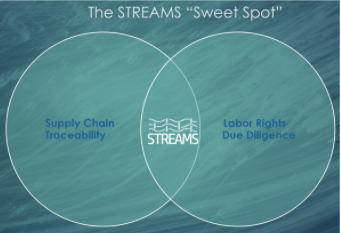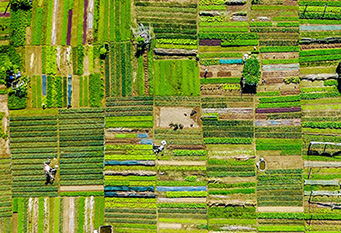About the Project: Excerpts from the May 2022 Newsletter

Note from the Director
Erin Klett, STREAMS Project Director
Companies are increasingly looking to supply chain traceability solutions to address the risk of labor abuse in supply chains and comply with a growing landscape of regulatory requirements. The STREAMS project has been working on a number of fronts to help support companies, governments and civil society to leverage traceability efforts toward the improvement of conditions for workers and their communities.
We know that traceability alone does not deliver better or more fair working conditions. But we also know that the supply chain insight that can be gleaned from traceability efforts – the who, what, when, and where of supply chains – can, and must, be leveraged to support a robust due diligence approach to labor and human rights.
If you share this interest in exploring the intersection of traceability and due diligence for improved labor conditions, I invite you to be in touch.

STREAMS Project Basics
The STREAMS project was awarded in December 2020 and will run for 4.5 years, through June 2025.
Working in collaboration with implementing partners including the Better Cotton Initiative, the Responsible Sourcing Network, and Sourcemap, the STREAMS project will:
- develop a Supply Chain Traceability Matrix for categorizing intersections between types of supply chain segments and types of tracing methodologies;
- pilot and validate the effectiveness of novel approaches to supply chain tracing in the garment sector of India;
- and create accessible tools to enable diverse actors across sectors and supply chain tiers to adopt innovative tracing approaches.

Coming Soon! The STREAMS Traceability Matrix
Verité is excited to announce that a new, publicly available resource – the Supply Chain Traceability Matrix – is slated for launch in late 2022. The Matrix is being designed as an accessible, interactive platform for users to learn about how different traceability approaches can help companies comply with due diligence frameworks like the OECD Due Diligence Guideline’s for MNEs, the U.S. Department of Labor’s Comply Chain, and the U.S. Department of State’s Responsible Sourcing Tool, with the ultimate goal of combating forced labor and child labor in different types of upstream supply chains.
The STREAMS Supply Chain Traceability Matrix will be comprised of three major content areas:
- A primer: providing a new approach to understanding the intersection between supply chain traceability and due diligence.
- The Tracing Methods Typology (TMT): providing explanations of different traceability methods, how those methods can be used to help combat forced labor and child labor in supply chains, the nature of information provided, and what types of supply chains they are compatible
- The Supply Chains Typology (SCT): providing information on supply chain characteristics that impact traceability feasibility for goods listed on the U.S. Department of Labor’s, List of Goods Produced by Child Labor or Forced Labor.
The STREAMS project is designing the Matrix to meet the needs of multinational companies, government representatives and regulators, and advocates. In the lead up to the launch, Verité will be working with expert advisors to validate the content and design. For more information, please reach out to the STREAMS team at streams@verite.org.

STREAMS Newsletters
Funding for the Supply Chain Tracing and Engagement Methodologies (STREAMS) project is provided by the U.S. Department of Labor under cooperative agreement number IL‐35805. 100 percent of the total costs of the project or program is financed with USG federal funds, for a total of 4,000,000 dollars. This material does not necessarily reflect the views or policies of the United States Department of Labor, nor does mention of trade names, commercial products, or organizations imply endorsement by the United States Government.

